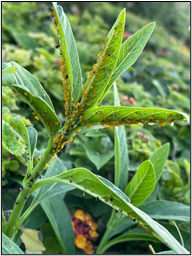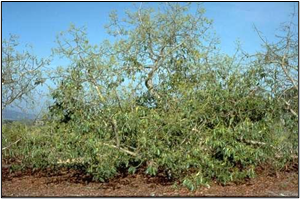Gretchen Heimlich-Villalta, UCCE Master Gardener and PhD student at UC Riverside
What Is IPM?

“Integrated pest management (IPM) is an ecosystem-based strategy that focuses on long-term prevention of pests or their damage through a combination of techniques such as biological control, habitat manipulation, modification of cultural practices, and use of resistant varieties. Pesticides are used only after monitoring indicates they are needed according to established guidelines, and treatments are made with the goal of removing only the target organisms. Pest control tools are selected and applied in a manner that minimizes risks to human health, to beneficial and nontarget organisms, and to the environment.”1 Mary Louise Flint, IPM in Practice: Principles and Methods of Integrated Pest Management ?
An Ecosystem-Based Strategy It's easy to skim over the ecosystem component of IPM; after all, it's a broad concept, and perhaps a bit abstract. But it's really important, so let's try to make it as simple as possible. Every ecosystem (the forest, the ocean, your garden, even your soil) is made up of individual members that do a couple things:
1. They get their energy from/feed on something(s) else.
2. They give their energy to/are fed on by something(s) else. ?
Together, the members of an ecosystem have roles that keep that system in balance and contribute to its overall function; they also provide services to humans. In your garden, this can include oxygen production, air and water purification, water capture and cycling, food production, climate regulation...I could go on and on, but I think you get the picture. Only a small portion of an ecosystem's inhabitants are pests of plants or humans. As gardeners, we are custodians of our garden ecosystems. It's a big responsibility—and an awesome opportunity!
Long-Term Prevention through a Combination of Techniques

Monitoring
In agriculture, farmers who practice IPM will pay close attention to details like pest numbers, natural enemies, and weather and field conditions. The home gardener will start by inspecting their plants regularly for damage and getting to know their common pests. Identifying plant pests can be a daunting task, but it's worth the effort. It's crucial to identify what's stressing your plant before attempting to treat the problem in order to avoid affecting non-target organisms. And by recognizing pests early, it may be possible to, say, knock back aphid populations with a shot of water from a hose instead of spraying insecticide once the population has gotten out of control.
So, Why IPM?
Using a combination of treatments is usually more effective than any single treatment for controlling pests. By optimizing cultural practices and using biological and mechanical controls, we can reduce or eliminate the need for chemicals. Integrated pest management allows us to reduce the damage of plant pests, and at the same time reduce the damage of pest treatments to our garden ecosystems, humans, and the environment. As thoughtful custodians of our landscape ecosystems, we can optimize plant health—and at the same time protect non-target organisms ranging from bacteria and fungi to birds, bees, and people. And this is a beautiful thing. For specific help with IPM in your own garden and landscape, contact a UCCE San Bernardino County Master Gardener volunteer at mgsanbern@ucanr.edu
Author info: Gretchen Heimlich-Villalta is an ISA™ certified arborist who has been a San Bernardino County Master Gardener since 2014. She received her AS in Integrated Pest Management from Mt. San Antonio College, where she has helped teach IPM since 2020. She received BA degrees in Creative Writing and Photography, and is currently working on her Ph.D. in Plant Pathology at the University of California, Riverside, where she is researching citrus root and soil health; she also helps manage the Strub Avenue Community Garden in Whittier. Sources: 1. Flint, M. L. IPM in Practice, 2nd Edition: Principles and Methods of Integrated Pest Management. (University of California Agriculture and Natural Resources, 2012). 2. Eskalen, A. & Faber, B. A. Phytophthora Root Rot. UC IPM https://www2.ipm.ucanr.edu/agriculture/avocado/Phytophthora-root-rot/ (2016). 3. Managing Pests in Gardens: Fruit: Cultural Tips: Fertilizing avocados—UC IPM. http://ipm.ucanr.edu/PMG/GARDEN/FRUIT/CULTURAL/avocadofert.html.